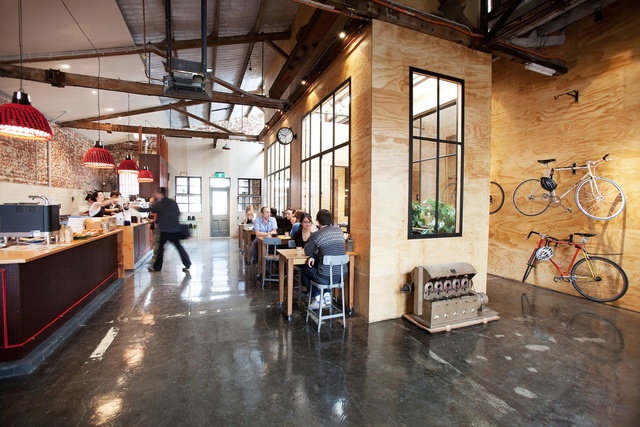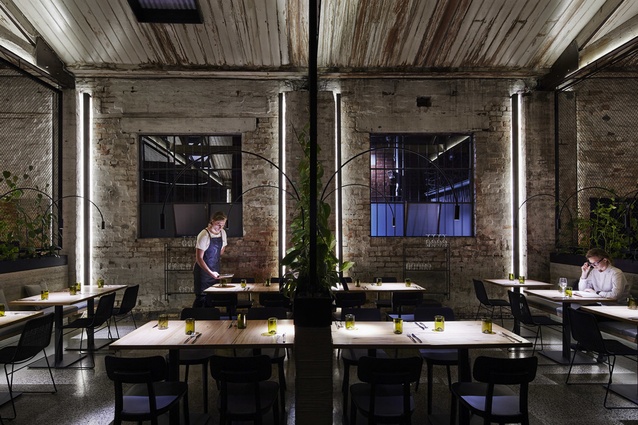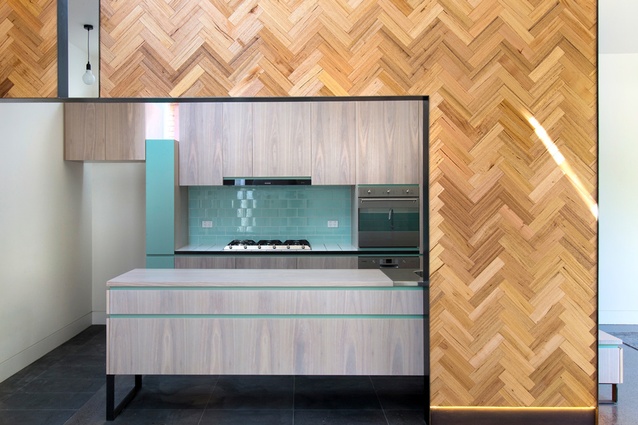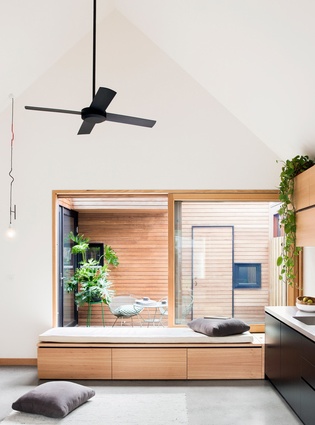Jeremy McLeod of Breathe Architecture
At the 2015 Australasian Student Architecture Congress, Melbourne architect Jeremy McLeod of Breathe Architecture presented his vision for Nightingale, a new triple bottom line developer model providing apartments that are environmentally, socially and financially sustainable. This begins by stripping the building of what isn’t needed: car parking, air conditioning, second bathrooms, real estate agents and display suits while occupants share facilities like the laundry and on-site energy production.
These projects are financed by ‘ethical shareholders’, mostly Melbourne architects who believe in the value of well designed apartments and who want to lead by example. The apartments' sale prices are capped, and so is the shareholder's profit, while all purchasers are interviewed to ensure they will live in the building rather than on-selling or renting.
For these Melbourne architects, it is their own little ‘slice of utopia’, with big implications for the future of the city. Auckland students Natalie Bradburn and Sam Aislabie had a chance to chat with McLeod about his early days and the future of this exciting project.

Sam Aislabie: How did you get started? When did you start your own practice?
Jeremy McLeod: I came to Melbourne at the end of a recession in 1997 and I had a wife and two young kids at that time and there were about 20 firms with work and they were all working on just one project, which was the Crown Casino. It was the last thing I wanted to be working on but it’s the place where I spent the first year of my professional career, working on a fucking casino! So my karma level as an architect was already in the red, before I’d even started a career.
After a year there I moved to Nonda Katsalidis Architects where we were doing some more creative housing projects. All of Nonda’s great works like Melbourne Terrace and Republic Tower were all lead by Nonda as developer. They have done lots of work but the ones which he was personally invested in were the groundbreaking ones. When I went for my interview, there were 8 architects and when I left there were 50, so it grew dramatically and became a much bigger thing. We started working on more and more developer lead projects and it got further and further away from those beautiful projects that Nonda was leading.
So I left and started my own practice and called it Breathe, the idea being that every room we built would have a window that you could open. That’s how it started, with just me for the first couple of years and then I employed some kooky German guy. Over 14 years we just grew, slowly and steadily and now there are 9 of us. We just moved into a small 72 square metre studio in the back of The Commons. We bought a space in there which won’t allow us to grow any bigger, and that’s intentional. We don’t want to be bigger, we just want to get better and we don’t want to do anything we are ashamed of.

So I started doing sustainable housing, the same way that any young architect would start, renovations in people’s backyards, for years without anyone ever knowing or hearing about us, until we did this pop up shop for my wife’s company called Lulamae. It was made of 100% recycled cardboard, and all of a sudden it went viral and people were asking us to cardboard structures all around the world. I was like, dude, we’re not cardboard architects, we’re just architects.
What we are really interested in as architects is sustainable urbanisation and how can we make that happen. We’ve got a massive urban growth curve, and we’ve got to house all these new Melbournians over the next 50 years if the predictions are right. At the moment our housing system is absolutely broken and we’ve just been incredibly frustrated with the development market for the last 10 years. So we want to be part of that solution, which is why we are pushing for Nightingale.
SA: Do you see using this Nightingale model for more than just housing, perhaps mixed use?
JM: Oh absolutely. What it does is puts the architect in charge of the destiny of the project. Architects have an incredibly broad education, we are able to think of things much more than just ’where to plant the bathroom’ or ‘where the toilet holder should go’, we can actually think strategically about the future growth of the city. When we were looking to buy Nightingale everyone was saying, ‘you are crazy, a warehouse next to a train – this is terrible’. Whereas I could see uninterrupted views to the west and incredible proximity to public transport. I saw all these strengths, as any architect would, and all the real estate agent could see was ‘oh it’s going to be noisy’. You know we are living in the city right, a bit of noise is good. So look, yeah absolutely. Can it be used for smart office? Can it be used for creative spaces? Absolutely.

SA: Are you working on anything like that at the moment?
JM: A lot of our head space at the moment, or mine personally, is in our goal to push Nightingale further over the left, over the next 10 years. We have open sourced our IP, we are giving it to any architect that is willing to sign a proforma that they are going to use it for the power of good, not just to line their pocket. We are only giving it to architects, not anyone else. But beyond all that, the goal is, long term, that we actually take the ethical investors out all together and we just connect the purchasers with the architect. At the moment as a purchaser you have to pay 15 percent to the ethical business investor, but imagine if you didn’t have to pay that, it could reduce the cost of the apartments by 30-60 thousand dollars. We could be selling apartments essentially $AU120,000 under market, and that would be good. That’s the long term goal.
NB: Have you always been able to be so selective with your projects?
JM: Absolutely not. There are probably three projects that you will never ever see in the back catalog of our work. Why did we take those projects on? Fundamentally, it’s the same old argument, that’s pretty pathetic really, but we just really needed the money. 2013 was a horrendous year for us financially, we just couldn’t land a job. So we took on a project in that year that was a house for some rich people down by the coast. We have parted ways with them now, but we should have never have taken it on. We have done some work for a developer, and we got them a planning permit and again we parted ways as soon as we could and that thing has since been built. It gets easier to pick and choose as you become more established, and because there are only 9 of us, we don’t have this kind of machine to feed. We don’t have hundreds of thousands of dollars in wages each week.
SA: Also, you mentioned working mainly with people a lot younger than yourself, is that deliberate?

JM: Absolutely. What happens in architecture, is that the idealism gets beaten out of you and a lot of people that we employ are straight out of university, which is again intentional. Breathe Architecture may lack depth of experience, but what we do have is idealists with incredible tenacity. It’s the way I like it, all these guys give a shit about the outcome. Everyone is younger, and everyone is smarter than me, I would have to have the lowest IQ in Breathe by a country mile. Every young graduate that we put on just seems to have a skill level that grows exponentially. They found my folio recently, and they were passing it around at lunch time laughing!
NB: You seem to have a close bunch of like-minded architects around you, is this a network from your days as a student or have you formed together while in practice?
JM: When we studied at the University of Tasmania, it was a pretty tight bunch, I don’t know whether it’s the same anymore. We all studied and worked in the same studio, and as we all graduated we all went to different cities to work in. In Melbourne, I found that some of my close friends from uni weren’t working in Melbourne. So when I started my own practice, I was quite isolated from the profession on the whole, but then I was working in Brunswick close to five other firms. Stuart Harrison (Harrison and White) was just around the corner from us and he invited us to friday night drinks at his office, and introduced us to a bunch of other architects.
It’s interesting, architects like Stuart Harrison and Simon Knott (BKK Architects) have actually been incredibly instrumental in banding together these Gen X architects. They’re the kind of minds that led that charge, and so that’s why there is this incredible collegiate atmosphere in Melbourne, largely because of those two practices. It’s non-competitive, and incredibly helpful. I can ring those guys and say ‘Oh, Simon, I’m working on this, how would you deal with this?’ and he will go ‘ Ah look, I’ve got something like that, I’ll send it through to you’ and James Legge (Six Degrees) might call me and say, ‘We are working on this train line what would you do with this?’ and I will go, ‘Here is my acoustic report and our detailing’ and we’ll send that out to him, and likewise if I want something from Six Degrees, I can call him. So we all help each other, all the time. But if I trace that back, that has been Stuart Harrison and Simon Knott driving that, bringing everyone together. And now there’s also younger firms like Monique and Scott Woodward (WOWOWA), they’re crazy but they’re great.














